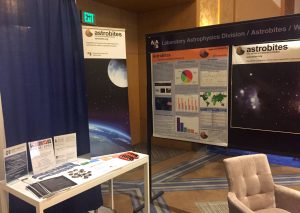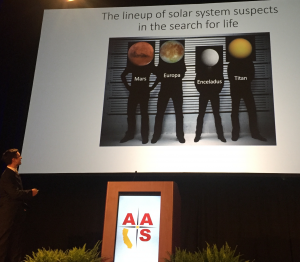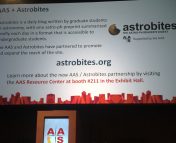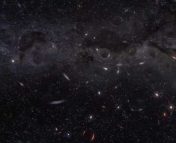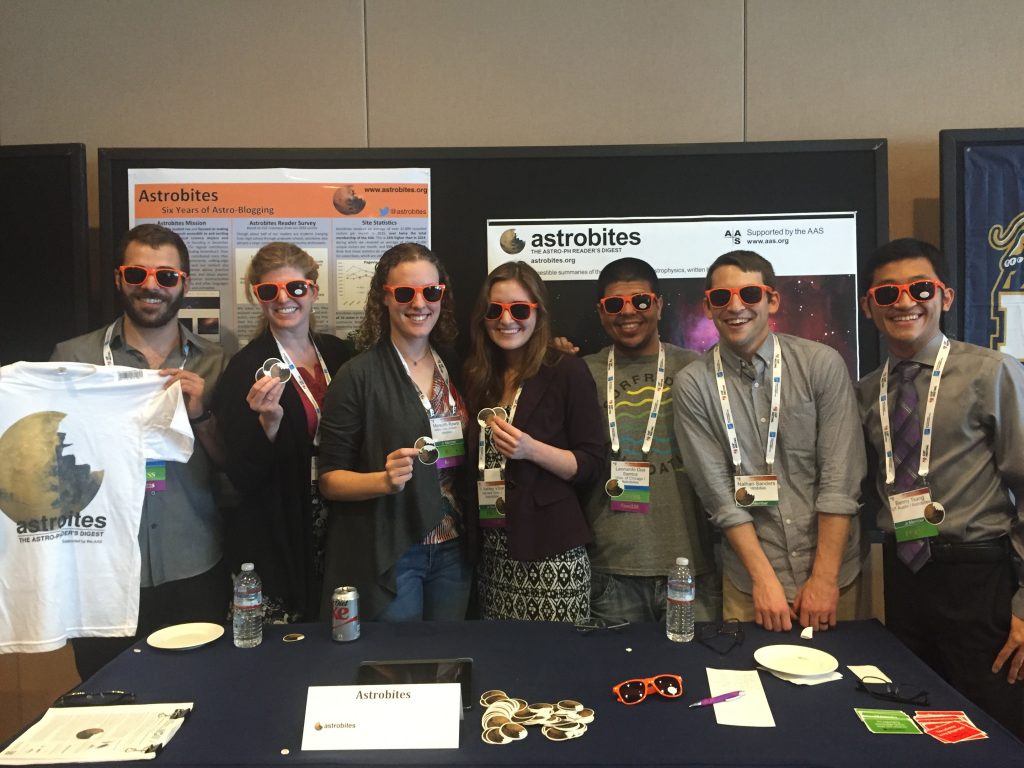
Astrobiters show off our San Diego spirit at the undergrad reception on Sunday night at the 228th American Astronomical Society Meeting.
Welcome to the summer American Astronomical Society (AAS) meeting in San Diego! A team of astrobiters is attending the conference this year, and we will report highlights from each day here on astrobites. If you’d like to see more timely updates during the day, we encourage you to follow @astrobites on twitter or search the #aas228 hashtag. We’ll be posting twice a day during the meeting, so be sure to visit the site often to catch all the news!
Things kicked off last night at our undergraduate reception booth. Thanks to all of you who stopped by — we were delighted to hear from undergrads who already know and love the site, educators who want to use it in their classrooms, and students who had not yet been introduced to astrobites and were excited about a new resource!
For the rest of the meeting we will be stationed at the AAS booth in the exhibit hall (booth #211-213), so drop by if you want to learn more (or pick up swag: we’ve got lots of stickers and sunglasses)!
Monday morning was the official start of the meeting. Here are just a few of the talks and workshops astrobiters attended this morning.
Opening Address (by Susanna Kohler)
AAS President Meg Urry kicked off the meeting this morning at 8am with an overview of some of the great endeavors AAS is supporting. We astrobiters had personal motivation to drag ourselves out of bed that early: during this session, Urry announced the new partnership between AAS and astrobites!
Urry touched on some difficult topics in her welcome, including yesterday’s tragedy in Orlando. She reiterated the AAS’s support for the Committee for Sexual-Orientation and Gender Minorities in Astronomy (SGMA). She also reminded meeting attendees about the importance of keeping conference interactions professional, and pointed to the meeting’s anti-harassment policy.
Partnership Announcement (by Michael Zevin)
This morning, the American Astronomical Society announced the new partnership that it will have with Astrobites! We are beyond excited to embark on this new partnership with the Society, which was the culmination of several years of supportive interaction. This new relationship is described further in the press release just issued by AAS.
First plenary: The Ocean World Enceladus (by Chris Faesi)
In the first plenary session of the AAS 228th meeting, Christopher Glein of the University of Toronto took the audience on an exciting tour of the ocean world Enceladus. This small, icy moon of Saturn had been thought rather unremarkable for most of the 2+ centuries since its discovery in 1789, but the Cassini spacecraft’s extended visit over the last decade has revealed it to be a surprisingly dynamic and unique little world. From Cassini’s 23 flybys, we now know that Enceladus is composed of roughly equal parts rock and ice, and, with an albedo of 99%, is the most reflective body in the solar system.
The moon’s surface is not entirely cratered, as are most solar system objects such as our own Moon, but has a southern hemisphere with long fissures that look like tiger stripes on an otherwise smooth surface. Follow-up with the satellite’s highly sensitive instruments revealed that these stripes were heated up to 200 K – much hotter than Enceladus’s typical 75 K surface temperature. There seems to be an energy shortage: the heating expected from Saturn’s tidal influence on the moon is a factor of about ten smaller than what would be required to heat the surface this much. Unraveling this discrepancy is still an area of active study today.
Learning about the chemistry of Enceladus’s plumes. It always amazes me how much we can learn from light! #aas228 pic.twitter.com/yklpClPjRD
— astrobites (@astrobites) June 13, 2016
Enceladus also spews powerful jets of salty water and water ice far into space via cryovolcanism, making it the smallest geologically active body in the solar system. Perhaps most intriguingly, this 500 km-diameter moon may be a promising target in the search for extraterrestrial life. The jets are highly alkaline and may contain molecular hydrogen, which links the inorganic and living worlds as a reactant and energy source. Although Cassini’s very fruitful mission will come to a close in 2017 with a death spiral into Saturn, the future is still bright for Enceladus. Glein closed with a preview of the next mission to this special moon: “ELF”, the Enceladus Life Finder, will fly through and analyze Enceladus’s icy plume in unprecedented detail using state-of-the-art instruments and is predicted to fly in 2031.
102: The NASA K2 Mission (by Meredith Rawls)
Everyone’s favorite planet finding telescope continues to impress. In this morning session, we heard highlights about how the repurposed Kepler mission (K2) is contributing to research in areas ranging from nearby brown dwarfs to extragalactic supernovae. The session kicked off with an overview by Knicole Colon, who happily reported extended funding for K2 through 2018, when its fuel is projected to run out.
Colon: despite a glitch in the celebratory cake, #K2mission has been extended until the end of life! #aas228 pic.twitter.com/9umZozOy0n
— Geert Barentsen (@GeertHub) June 13, 2016
Bradley Tucker discussed recent extragalactic results from K2, and supernovae in particular. So far, the Kepler Extragalactic Survey has found 17 supernovae and they hope to find at least 20 more in the next three years. Because Kepler observations are so frequent, they reveal previously hidden subtleties in how supernovae fade over time.
.@btucker22: #K2mission is providing a statistical sample of high-precision supernova lightcurves! #aas228 pic.twitter.com/GWZUJhtmRW
— Geert Barentsen (@GeertHub) June 13, 2016
Of course, exoplanet science is still a primary goal for the K2 team. Matthew Penny updated us on the status of the in-progress microlensing campaign, which uses Kepler to search for one-off brightening events that indicate the presence of a planet due to gravitational microlensing. Work is also underway by Jeffrey Coughlin and colleagues to improve our ability to automatically detect and confirm exoplanet candidates with the traditional transit technique. They have developed a robotic technique called DAVE (Discovery And Vetting of K2 Exoplanets), which does an impressive job of eliminating false positive eclipse signals. To complement K2 observations of exoplanet transits, astrobites alumna Courtney Dressing presented a method which incorporates observations from the infrared Spitzer Space Telescope to better refine planet properties such as radius.
@AstroDressing: Spitzer lets us refine Kepler planet radii, orbits, and even masses in prep for the Webb. #aas228 pic.twitter.com/qAUHeUSMYa
— Meredith Rawls (@merrdiff) June 13, 2016
One of the challenges of K2 compared to Kepler is noise introduced by the spacecraft’s less precise ability to point. Derek Buzasi implored us to not consider any one pipeline that removes this jitter as necessarily “best,” but rather to try several and recognize that different science goals will need different approaches to data processing.
There isn’t one best K2 pipeline! Depends strongly on your science goals. Buzasi begs us not to rank them. #aas228 pic.twitter.com/ykl89WqKNk
— Meredith Rawls (@merrdiff) June 13, 2016
Jeffrey Van Cleve showed examples of what can be accomplished when K2 data is appropriately processed: just like Kepler, K2 can use asteroseismology to see the ringing oscillations of acoustic waves inside evolved stars.
More gorgeous asteroseismology coming out of K2! Thanks to K2P2 pipeline’s handling of calibrated pixels. #aas228 pic.twitter.com/dGY6DcZHlV
— Meredith Rawls (@merrdiff) June 13, 2016
Finally, several speakers including Buzasi presented their work on stellar astrophysics with K2. In addition to stellar activity and asteroseismology, presenters discussed spots and flares on cool brown dwarfs (John Gizis) and using eclipses together with stellar models to measure distances to star clusters (Keivan Stassun). Not a bad roundup for a broken space telescope!
103: Galaxies Big and Small (by Ben Cook)
This session (one of the first parallel sessions of the conference) included a variety of presentations studying galaxies, primarily using observations but ending with a unique purely analytical study. Stephen McNeil began the session by discussing a survey looking for dwarf galaxies in “voids” — the most empty spaces in the universe. Candidate objects can be looked for using a smart choice of photometric color bands, but more work is ongoing to confirm the locations of (and distances to) the objects with spectroscopy. Aaron Romanowsky gave an overview of the field of Ultra-Diffuse Galaxies, a new class of galaxies only discovered within the last 2 years. Some of these galaxies are as large as the Milky Way and seem to have almost as much dark matter, but they contain 1000x fewer stars.
![A high-redshift galaxy which is "gravitationally lensed" by a large cluster is shown to the left. The right image shows how big it would look without the magnification. [Slide by Greg Walsh]](https://astrobites.org/wp-content/uploads/2016/06/image4-300x225.jpeg)
A high-redshift galaxy which is “gravitationally lensed” by a large cluster is shown to the left. The right image shows how big it would look without the magnification. [Slide by Greg Walsh]
Bill Forman discussed how many galaxies have extremely hot, ionized gas surrounding them, and Bruce Rout argued that dark matter may not be necessary to explain the rotation curves of galaxies; a complicated analytical model using general relativity can do the job without any dark matter at all.
105. College Astronomy Education: Research, Resources, and Getting Involved (by Anson Lam)
Planet formation is one of the most important topics in introductory astronomy courses, and the discovery of thousands of exoplanets over the past decade make this even more so. The ubiquitous nature of this subject material makes it useful for probing student understanding using concept inventories. One of the objectives of this study is examining whether having previous science knowledge actually contributes to student knowledge and learning. The results of this study are due to come out in 2017.
Conceptual Frameworks in Astronomy (David Pundak)
There are lots of different methods by which one can examine how students understand or misunderstand astronomical concepts. For example, by asking questions such as “Has the Earth always existed?”, this can be a way to examine the worldviews through which students conceptually understand the universe. From surveys collected over a 20 year period, middle school students are more geocentric (having their worldview of the Universe focused on the Earth), while HS students possess more a heliocentric perspective. In general, students progress from a geocentric to heliocentric worldview as they progress through school. However, students who hold a sidereal worldview (i.e. realizing that out Sun is just another star out of billions) is relatively low, perhaps because they haven been exposed to a proper astronomy course yet.
An analysis of learners in intro astro MOOCs (Sanlyn Buxner)
Massive Open Online Courses (MOOCs) have been hugely popular in recent years, and these classes produce a tremendous amount of quantitative data regarding the habits and demographics of a huge group of independent learners. From examining over 20,000 students initially enrolled in the course, the study finds that students who complete the first assignment are the most likely to complete the entire course (around 350 finishers). The study also finds that students with higher levels of education, or having backgrounds from technical fields, are more likely to finish the course. MOOC learners are generally more knowledgeably about science and have a stronger prior background compared to most students enrolled in a typical introduction to astronomy course.
Mind the Gaps: Wikipedia as an education model and public duty for scientists (Greg Boustead)
Wikipedia is one of the first sources from which the public finds their information about science, but there are significant knowledge gaps for highly technical material and some of the material is out of date. In alignment with the Wikipedia Year of Science 2016, it is crucial that scientists become aware of this need to be filled. One way to fill in the knowledge gaps on Wikipedia is to encourage astronomers have their students write Wikipedia articles instead of term papers in their courses.
Press Conference: Exoplanets and Brown Dwarfs (by Susanna Kohler)
The first press conference of the meeting featured four speakers discussing some of the latest developments in the field of exoplanet and brown dwarfs.
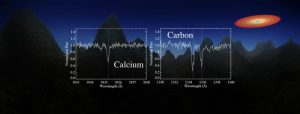
Artist’s impression of the surface of a massive, planet-like body being devoured by a white dwarf. [A. Hara/C. Melis/W. M. Keck Observatory]
First up was Carl Melis (UC San Diego), who discussed the discovery of a rocky exoplanetary body currently being shredded by a white dwarf. As the white dwarf’s strong gravitational pull tears the body apart, we can observe the material pulled from its surface layers. These observations — made by Keck Observatory and Hubble — indicate that the body might have been Earth-like, with an outer surface of made up of limestone. Here’s the press release.
Next, Avi Shporer (NASA Jet Propulsion Laboratory) spoke about the first transiting brown dwarf found in K2 mission data. Stars like companionship, but the companions are usually other massive stars, or Jupiter-size or smaller planets. Companions with the mass and size of brown dwarfs are uncommon, leading to the term “brown dwarf desert”. The brown dwarf found by K2 marks the 12th transiting brown dwarf we have discovered.
Jerome Orosz (San Diego State University) was up next, presenting the largest and longest-period circumbinary planet yet discovered. This planet is in an orbit with a 3-year period around a two-star binary system (think Tatooine!). This is the longest orbital period of any confirmed transiting exoplanet, and this Jupiter-sized planet, which is in the circumbinary’s habitable zone, is the largest circumbinary planet we’ve observed. Here’s the press release.
Jerome Orosz on the largest and longest-period circumbinary planet found in Kepler data #aas228 #tatooine pic.twitter.com/2wngVJWEzH
— astrobites (@astrobites) June 13, 2016
Finally, Sean Mills (University of Chicago) spoke about Kepler-108, a giant planet system in which the two exoplanets don’t orbit within the same plane. This is detectable because the transits of these planets occur at different times and have different depths in the light curve each time they orbit. Their misalignment may have been caused by a past collision with another planet, which was kicked out of the system in the process.
The LIGO-VIRGO Forum on Hunting Gravitational Wave Counterparts (by Gourav Khullar)
This parallel session, organized by Peter Shawhan (University of Maryland, advancedLIGO) discussed the first major followup campaign of the GW150914 gravitational wave (GW) discovery event by the physics and astronomy community around the world. It was extremely exciting to hear the speakers talk of the actual process behind the mega-collaborative effort following the first GW event.
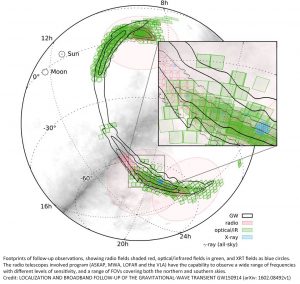 This paper, published on June 3rd this year, was described by Peter, with a strong emphasis on the timeline following the GW alert in raw LIGO data back in September 2015, along with description of the sky map and raw data given to different facilities and collaborations that LIGO-VIRGO had signed Memorandums of Understanding (MOUs) with for rapid and robust followups. The talk also focussed on resources and tutorials available now to unpack and characterize future alerts data from LIGO-VIRGO.
This paper, published on June 3rd this year, was described by Peter, with a strong emphasis on the timeline following the GW alert in raw LIGO data back in September 2015, along with description of the sky map and raw data given to different facilities and collaborations that LIGO-VIRGO had signed Memorandums of Understanding (MOUs) with for rapid and robust followups. The talk also focussed on resources and tutorials available now to unpack and characterize future alerts data from LIGO-VIRGO.
This talk was followed by the description of the all sky survey PAN-STARRS, and its joint efforts with LIGO. It was pointed out that PAN-STARRS had already scanned the sky multiple times, which gave the program an edge in determining transients, i.e. recent features appearing on their new maps but not the old. This extensive survey also allowed better characterization of the transient source, which would be the next step for PAN-STARRS and other similar projects.
Our @LIGO booth at #AAS228 is up and running – drop by for a chat about #gravitationalwaves pic.twitter.com/akt9wsVPT6 pic.twitter.com/kmPz3oxzJf
— LIGO (@LIGO) June 13, 2016
Following this was a talk by Andy Howell, of the newly formed Las Cumbres Observatory – A Global Telescope Network (LCOGT), made up of multiple telescopes across the US, Chile, Spain, South Africa, China and Australia. Howell emphasized that a robotic pointed-search facility could be extremely crucial in automated alert triggering of GW events in the future. Their galaxy and transient catalog is one to look out for.

